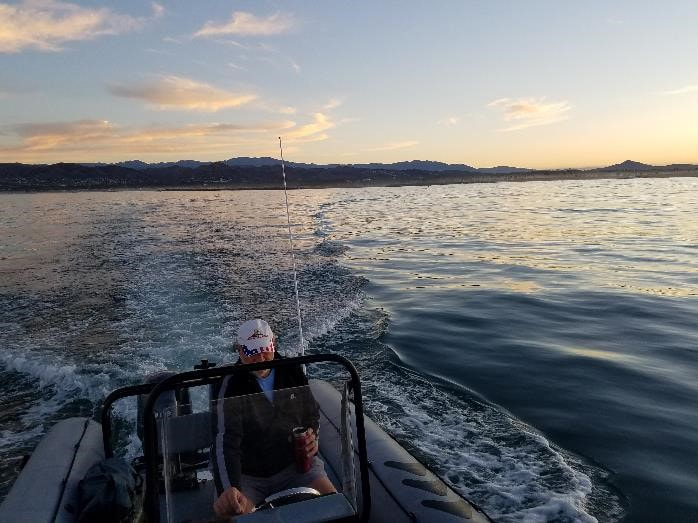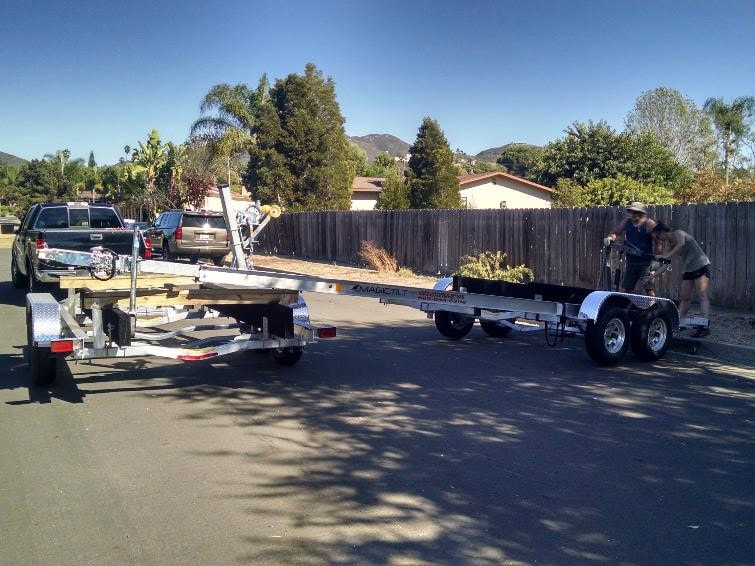|
As we mentioned in our last post, we’ve added a new boat to our fleet, the R/V Phoenix: A 2017 Zodiac Pro 750 rigged with twin 115hp Yamaha four stroke engines. We chose this boat based on our past experience with our 2009 Zodiac Pro 650, which has exceeded our expectations. Our 750 has the same internal components (console and bolster seat), which means that all the extra length and width of the boat translates into additional deck space. There were a ton of moving parts associated with this purchase. To start, the boat and two trailers were delivered to the dealer in Ventura California, and we needed to get all three down to Vista, CA for the next phase of this adventure. One of the trailers needs to be shipped to San Clemente Island, the boat needs to have a bow pulpit fabricated, electronics need to be installed, and all this has to be done in a short period of time since we all live in Washington! Thanks to the support of Inflatable Boat Specialists in Ventura CA, Phoenix went from shrink-wrapped on the delivery truck with the tubes off, to prepped and ready for sea trials (including the installation of some of the electronics) in just 2.5 days! Today’s puzzler: How do you move two trailers, one boat and one truck from point A to point B in one trip? This was the puzzle we faced when taking delivery of Phoenix, and here’s how we solved it: Greg went to Ventura to inspect the boat and help layout the installation of electronics. Brenda, Erin and Sebastian went to Vista to gather up gear that would be needed for a boat trip from Ventura to Oceanside, including research gear (we never miss an opportunity to conduct science). On Friday, Brenda and Erin’s dad, Frank, jumped in his truck and drove up to Ventura to meet up with Greg and the boat. Phoenix was launched for initial sea trials (teaser, we hit 48 knots!) and stayed in the water overnight in Ventura. The now empty trailer went back to Inflatable Boat Specialists where the crew used a fork lift to stack the second trailer on top of the first for transport. Early Saturday morning Greg and Frank motored out of Ventura Harbor for the 130 nautical mile run down to Oceanside, while Brenda had the unenviable job of towing the two stacked trailers through Los Angeles, down to Vista. The trip on the boat started with a gorgeous sunrise, and the rest of the day followed suit. While much of the trip was done at relatively slow speeds as part of the break-in procedure, the seas were calm and the trip only took 9 hours. Meanwhile, Brenda arrived in Vista with the two stacked trailers, and since she and Erin did not have the luxury of a forklift, had to use some ingenuity and muscle to get the two trailers un-stacked. Using an engine hoist and elbow grease (with a huge shout-out for the helping hand from Erin’s brother), they got the two trailers un-stacked just in time to head to the ramp to pick up Phoenix from her first full sea trial. We spent Sunday working on smaller details (installation of safety gear, additional electronics, trailer modifications, etc.), as well as some unexpected hiccups. This leads us to Puzzler of the day # 2: What is going to be heavier in the water: a typical galvanized box-frame trailer (which can trap air inside the trailer frame), or an aluminum I-beam trailer which is made from lighter material but has no air trapped inside? This was a question we had pondered before we purchased these trailers, yet the answer was not clear—forums on the web suggested that floating of aluminum trailers was a problem, but mainly for triple axel trailers. However, in our short experience, we can tell you that a tandem axel aluminum trailer is pretty close to neutrally buoyant in salt water. Our trailer was floating back and forth with only a small amount of current inside a well-protected harbor. This is a problem because we are routinely operating at an unprotected boat ramp where seas that will move a heavy single-axle galvanized trailer are common. Today the boat is going to marine fabricators to get a bow pulpit built (an essential piece of equipment for our operations) and a few other odds and ends to complete before flying back to WA mid-week. With any luck (and a bunch more hard work), the boat will be ready for us to use on our next field project in early November.
As we mentioned previously, we will take every opportunity to conduct research when on the water. Overall, the transit down was very quiet with only a couple of sightings (common and Risso’s dolphins). It was quiet for marine life, that is. Trash was another story. We collected 44 mylar and latex balloons, debris that is mistaken as food and ingested by animals. Wads of ribbon serve as perfect entanglement traps. This number only accounts for the ones we were able to retrieve. It’s typical for us to find balloons dispersed far and wide and we are just not able to collect everything given time constraints. We find this frustrating. How can you help? Prevent the problem. Don’t release balloons and pass the word on! When you find one, pick it up and dispose of it properly. Balloons can be found everywhere but especially so on the water. Boaters, you have an opportunity to make a big difference. Please consider making a positive change and committing to clean up the environment while out enjoying your day. If we all come together, we can accomplish great things!
2 Comments
Anyone who has spent a significant amount of time at sea will recognize the inherent risks of taking a small inflatable boat 40 to 50 miles offshore on a routine basis. Where we operate, there is no protection from the ocean swells, and no large support vessel to pluck us out of the water when the weather picks up. It is rare for us to be operating in conjunction with other vessels, meaning we are out there on our own. Training, experience, and good judgement are key factors in mitigating risks of operating far offshore. Having the right equipment is also critically important. In this blog, we will highlight our current workhorse of a boat, the R/V Physalus, and introduce the carefully chosen, newest member of the fleet, the R/V Phoenix. R/V Physalus (the species name for the fin whale) is a 2009 Zodiac Pro 650, manufactured in North Carolina by Zodiac North America. She is part of a class of boats known as a Rigid Hull Inflatable Boat (RHIB), meaning a fiberglass hull with inflatable tubes surrounding it. RHIBs are inherently stable boats (when operated appropriately), and substantially lighter than a traditional hull of similar size. This results in significantly improved fuel economy—important given our average day at sea covers more than 100 nautical miles (maximum of ~175), and fuel capacity is limited. Twin 75 horsepower Honda outboards power Physalus, so we have enough juice to keep us out of trouble should one engine go down. In the 8 years we have been operating Physalus, we have logged more than 3,000 hours on the water and covered more than 34,600 nautical miles (>40,000 miles or 63,000 kilometers)—that’s the equivalent of having traveled around the globe at the equator more than 1.5 times! During that time, the boat has seen her share of rough weather, including one transit that ended up cracking the hull of a 60’ charter boat that we were working with at the time. Yet, Physalus remained sound and handled the seas with the confidence of the best rough weather boat. In all our time in Physalus, we’ve only had to do minor repairs to the inflatable tubes, and no repairs to the fiberglass hull, despite the tremendous stress put on it. While Physalus will remain our principle research platform, her lack of deck space to accommodate three people in addition to all our research gear, as well as the need for two simultaneous boats for some projects, has led us to investigate adding a second boat to our fleet.
Given our humble origins (in other words, a new-start, small non-profit with no real fundraising mechanism), we initially looked only at used boats. However, our needs in terms of how the boat is configured are pretty specific, and any used boat of sufficient quality we found would have needed costly modifications. We also kept revisiting the fact that Physalus has been a perfect boat for us and we have absolute faith in her abilities to do the job safely. We decided to reach out to Zodiac North America, and in particular, the dealer Inflatable Boat Specialists in Ventura, CA from whom we had purchased Physalus. We sent them a short blurb about our new organization, accomplishments, and history with Physalus, and asked if there was any way they could help support our work. Inflatable Boat Specialists responded immediately and helped us secure a brand new Zodiac Pro 750 with twin 115hp Yamaha outboards at a price point that fit our budget. This new boat, which we have named the R/V Phoenix, is longer and wider than Physalus, providing us with the additional internal space we need for projects which require three personnel on board and/or more research gear. We are spending the next week in California taking delivery of the boat, running sea trials/breaking in the engines, and outfitting her with the electronics, safety equipment, bow pulpit, and other gear we need to have her ready to go to work on our next field effort in November. We’ll post pictures of our new boat in the next few days, but wanted to share the exciting news! Now we just need to find a dealer or generous person(s) to help us obtain a truck to tow the boat! Guess we put the cart before the horse, but that’s always been our style. In the meantime, we’ll continue to rely on the fantastic support of Frank and Jane Falcone, and borrow their truck. |
AuthorClick here to learn about our research staff. Archives
August 2022
Categories |
Proudly powered by Weebly










 RSS Feed
RSS Feed